I went to the Yayoi Kusama Exhibition today, at Museum MACAN (Museum of Modern and Contemporary Art in Nusantara) in West Jakarta with a high school friend. Today was meant to be a day off the travel fellowship yet I found links to it, particularly the area on identity. 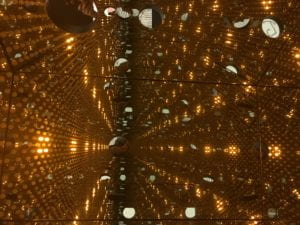
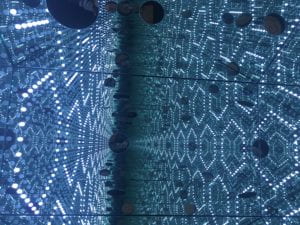
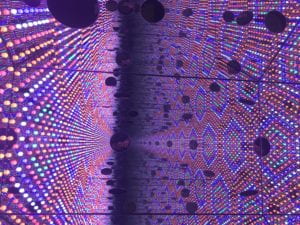
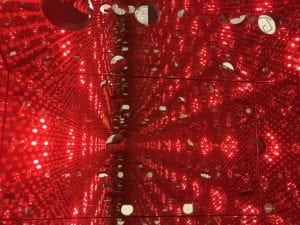
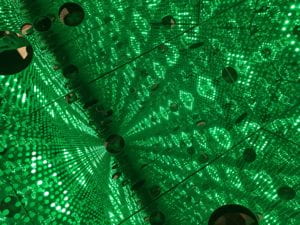
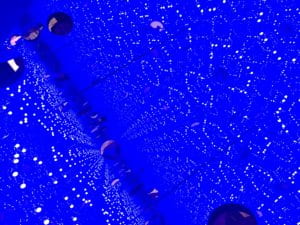
A little background on Yayoi Kusama: She was born in Japan in 1929 and started to paint using polka dots and nets as motifs at around age ten, and created paintings in watercolors, pastels and oils. (Her parents were against her being an artist but she was determined). After decades of achievement, she showcased her recent exhibition “Life is the Heart of a Rainbow” half a year ago in National Gallery of Singapore (When I went, they ran out of tickets), and now, Jakarta.
There was a common theme in all of our art- polka dots. She tells the story of how when she was a little girl she had a hallucination that freaked her out. She was in a field of flowers when they all started talking to her; the heads of flowers were like dots that went on as far as she could see, and she felt as if she was disappearing or as she calls it “self-obliterating”- into this field of endless dots. The weird experience influenced most of her later work. By adding all of these dots/marks, she feels as if she is making them (and herself), melt into, and become part of, the bigger universe.
Kusama said: “‘Our earth is only one polka dot among a million stars in the cosmos. Polka dots are a way to infinity. When we obliterate nature and our bodies with polka dots, we become part of the unity of our environment’. “
[http://www.tate.org.uk/kids/explore/who-is/who-yayoi-kusama]
In the room where we could stick the polka dots where we wanted, the deeper meaning for me was that we could choose where we stand in society. Like how the earth is only one dot among a million stars, each of us is one dot on Earth, and even though as individuals we are one small dot, we can choose where we place ourselves, which gives us a lot more agency than one would have originally thought (considering the number of dots there are in the room/on Earth). Where we choose to place ourselves not only says something about ourselves, but also our environment, because we chose to place ourselves in that place for a reason, indicating common ground between individuals; and/or that specific area means something to you. Also, when we go into the room, we don’t take off other people’s stickers, we choose places to put our stickers, implying how other people’s identities are not an obstruction to our own, because we are all so different. Additionally, there are many stickers on each page that we get, which symbolized (to me) that we can have multiple identities, and that it’s not a one-size-fit-all (with the different sizes of stickers), and that our identities are not singular; there are different shades of it because of our multi-dimensional identities.
What struck me the most was one exhibition that had all the things that Kusama saw in her life, and they were drawn by her sitting in the middle of a canvas, and drawing things around her. This reminded me about how people construct their identities according to what is important to them. For her, when she sees her art, she knows what it’s about, but to us, when we see it, we see everyday life objects that do not carry specific meaning to us. This made me think about how our identity is really only important to us, and not special to anyone else; no one cares about our identity as much as ourselves, so we should and can construct it in a way that makes sense to us, instead of trying to make it fit universally/ in a way other people can understand and de-construct. The dots and nets that Kusama uses in her art are very ordinary patterns, but are specific motifs to her (the hallucination she had as a child). However, to us, they are just pretty and colorful dots that serve as great backgrounds for a new Facebook profile. This made me think about how everyone has different perspectives on things, and what is important to someone else may carry a different meaning to us, and we will never truly understand how something is important to an individual, how personal it may be, and how it affects who they are. Our identity is something that we construct, and can only unpack and understand ourselves, and even if we try to explain it to others (by having captions next to art pieces like Kusama had), they will never truly understand it unless they step into your body and thoughts. No matter how many interviews we go through and how many museums we visit, the only way to understand a person, what their identity is, and the experiences that have shaped them, is to be them, and because that is impossible, we can only try to understand and empathize, instead of deconstructing what a person’s identity is, in order to make our own, because at the end of the day, our identity is only important to us, so we should construct it in a way that makes it most comfortable and logical to us, since it does not matter to anyone else anyways.